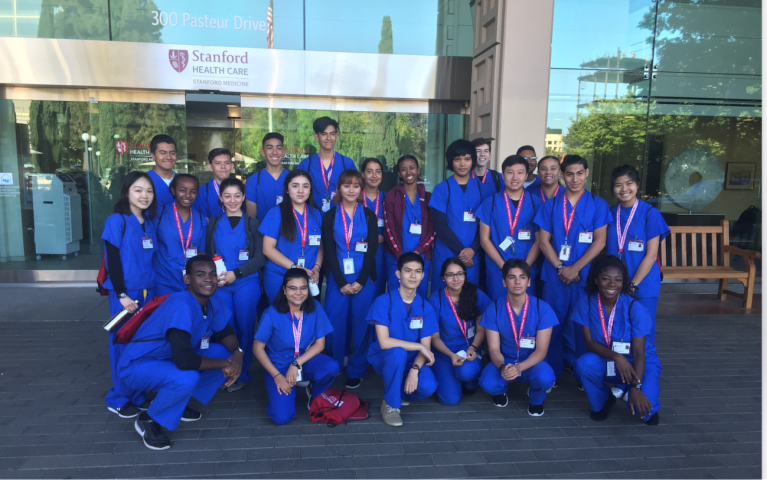The Stanford Medical Youth Science Program, a free five-week summer residency program for low-income high school students, kicked off on June 24. The program strives to encourage students of underrepresented minority groups in the Bay Area to pursue careers in medicine in order to increase diversity in the medical field. The program ran from June 24 to July 28 and encompassed a wide variety of learning opportunities, such as lectures from medical professors, laboratory workshops and a hands-on internship at the Stanford Health Care hospital.
The 24 accepted participants reside in a dorm house for the duration of the program. They live alongside the program counselors, who are Stanford medical and biology students.
The participants attend lectures from reputed medical professors and participate in labs and workshops. They also intern at Stanford Health Care, where they have the opportunity to observe surgeries or do simple tasks, such as taking a patient’s heart rate. The hospital internship allows the students to interact with patients and gives them authentic medical experiences.
While SMYSP focuses on medical education, the program also teaches participants how to function at a college level and navigate applying to universities. Program counselors teach workshops on preparing for the SAT, writing college essays and synthesizing information for research projects. They also teach several lessons on how to acquire financial aid for college, as a majority of the participants come from low-income backgrounds.
“I think the primary goal is to give students the tools to be successful in whatever it is they want to do,” said program counselor Amanda Rizkalla ’21, who is also a Stanford Daily columnist. “If it’s medicine, great. If it’s not, we still provide them with everything they need to know about getting into college.”
According to its record, SMYSP’s approach has been successful in equipping the students for their next steps. The program has kept tabs on its alumni for the past 30 years and currently, over 90 percent of the alumni are in college or have already graduated college.
“[A] majority of our students have gone off to go into the health professions, whether that be nursing, clinical practices, physicians or to allied health careers,” said Alivia Shorter, the director of diversity and outreach of the program. “[Our students] are going to college and succeeding in college. They are going to the health sciences for their majors and entering the health professions, which is our ultimate goal.”
SMYSP aims to support the creation of a diverse healthforce. Shorter believes that this is the key to improving the quality of healthcare in America. Specifically, she cited a lack of cultural and ethnic connection between patients of minority races and their health providers as the issue in America’s healthcare system.
“The population of California and the United States is increasingly diverse,” Shorter said. “That’s a beautiful thing. Diversity is not something to be afraid of but something to be proud of. As our population becomes increasingly diverse, having a health workforce that can connect with that patient population means that the patients will have a better experience with their care [and] that they will get quality care.”
Currently, SMYSP only accepts 24 students every year. The program is constantly looking for ways to reach even more underprivileged students in the Bay Area without sacrificing quality for quantity, and still ensuring that every participant receives the support they need to maximize their learning.
“We do feel that having this small community feel is [the] reason for the success,” Shorter said. “The program is complicated, because we want them to have the full, comprehensive exposure to [the medical field].”
Program participants are given authentic exposure to the medical field through opportunities to perform labs and gain familiarity with hospital procedures. Although these activities are costly due to the use of expensive lab and hospital equipment, all participants are given a full scholarship. Funding from the medical school, as well as from private donors, allow SMYSP to subsidize some expenses. That said, Shorter believes that with more sustainable funding, SMYSP can reach many more underprivileged students.
While funding is a crucial factor in SMYSP’s success, participants say the program counselors are the backbone of the program; they teach lessons at workshops, accompany students to their hospital internships and take the students on outings to museums and theater shows. Some of the counselors, such as Rizkalla, come from a low-income background themselves, which Rizkalla explains helps them connect with the SMYSP participants on a deeper level.
“Me and the other counselors who are first-generation, low-income college students, we know a lot of what the students are going through,” Rizkalla said. “I think that we understand each other better. A lot of what they’ve gone through is a variation of experiences that we’ve also gone through.”
According to program participant Nisrine Rahsaoui, who identifies as a low-income student and is from San Francisco, SMYSP is very intense with little downtime. She has found the past few weeks to be tiring but very rewarding. She was always interested in medicine, but said that her school didn’t provide her with the exposure and support she needed to feel confident about pursuing a career in the medical field.
“This internship definitely helped me feel like I’m more prepared for the journey,” Rahsaoui said. “The environment [at home] is very hard to succeed in. [For me], even a chance to pursue a career in the medical field is incredible.”
Contact Swara Tewari at tewariswara ‘at’ gmail.com.
